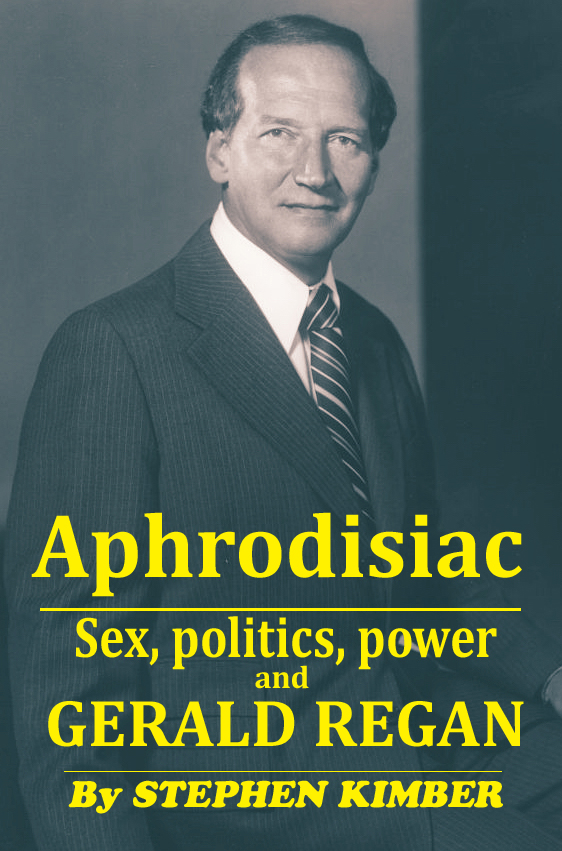From the April 25, 2002 edition of The Coast, Halifax
“vin·di·cate”
To clear of accusation, blame, suspicion, or doubt with supporting arguments or proof.
— The American Heritage Dictionary
“I am not guilty of these charges and never was. I am deeply gratified to be vindicated. Through many years, I served the province that I love and my country in public life to the best of my ability. Now I want to get on with what’s left of my life. I hope I can contribute in volunteer efforts to Nova Scotia as I was doing in the early ’90s before all this happened.”
— Gerald Regan April 17, 2002
“In the end, justice was done. He knows . . . he was vindicated of every serious charge.”
— Eddie Greenspan April 17, 2002
By Stephen Kimber
 Regina v Gerald Augustine Regan was always about more than its legal outcome, certainly about more – and less – than such elusive, ethereal notions as truth and justice. For Gerald A. Regan, accused serial sexual predator, this case was ultimately all about vindicating Gerald A. Regan, former provincial premier, former federal cabinet minister and wannabe elder statesman of Canadian politics, and then rehabilitating him in the eyes of the courts, the right-thinking public and of history.
Regina v Gerald Augustine Regan was always about more than its legal outcome, certainly about more – and less – than such elusive, ethereal notions as truth and justice. For Gerald A. Regan, accused serial sexual predator, this case was ultimately all about vindicating Gerald A. Regan, former provincial premier, former federal cabinet minister and wannabe elder statesman of Canadian politics, and then rehabilitating him in the eyes of the courts, the right-thinking public and of history.
It didn’t.
And it won’t.
In the courts, the critical issue of whether Regan did all the many and various nasty things women said he did turned out to be, at best, a wash. He was found not guilty of rape and attempted rape, but close to a dozen other sexual assault charges against him that will never be tested in a court of law still hang over him like a dark cloud. And plenty of other similar allegations, though they never were the subject of formal criminal charges, are now public as a result of the legal process. The courts, of course, were only one of the two parallel battlefronts on which Regan and his lawyer Eddie Greenspan have waged their nasty, brutish, uncivil war against the world – the complainants, the prosecutors, the police, the media – for the past nine years. In the provincial and federal courts of law, Regan was – in the infelicitous phrasing once ascribed to Greenspan -prepared to fight the allegations against him to “his last breath or his last penny, whichever came first.” In the second battleground, the court of public opinion, Regan and his high-priced defender were equally prepared to use every arrow in their quiver, including, if necessary, the occasional untruth, to protect whatever was left of Regan’s tattered reputation and his besmirched place in Nova Scotia political history.
The problem was that, in order to win the battle in the courts – the battle to keep Regan out of jail – Greenspan and Regan had little choice but to do things that would cost his client any hope of winning the battle for the hearts and minds of the public.
Last week, Greenspan and Regan won their final legal battle with a whimper rather than a bang when Nova Scotia’s prosecution service – despite a Valentine’s Day Supreme Court of Canada ruling in its favour – announced it would not proceed to trial on eight remaining sexual assault charges against Regan. Their reasons for giving up, as the prosecutors outlined them in a press conference last Wednesday, involved the age of the allegations against the former premier, the huge costs of conducting trials followed by appeals and probably still more appeals, the reluctance of some complainants to testify again and, of course, the fact Regan would probably never spend a day in jail even if he was convicted. But, in explaining their reasons for dropping the charges, the prosecutors – significantly – never once suggested they believed there was insufficient evidence to proceed.
But no matter. The legal case of Regina v Gerald Augustine Regan was finally over. And Regan had… not lost.
But it was, at best, a Pyrrhic victory. Gerald Regan was not, as he and Greenspan would claim in separate public victory statements, “vindicated.”
Not at all. The charges were not dismissed. He was not found Not Guilty. He simply will no longer have to face them in a court of law. But, in the court of public opinion – arguably the more important venue for a public figure like Regan with a keen sense of history and an acute sense of his place in it – Gerald Regan has long since been judged, convicted and consigned to join former U.S. President Bill Clinton, American Senators Gary Hart and Robert Packwood, Canadian MP Jack Ramsay and British Columbia cabinet minister Robert Blencoe in the pantheon of disgraced politicians whose accomplishments will forever be overshadowed by allegations of sexual misconduct.
Even within that notorious group, Regan’s was a special case: he was accused (though not always charged, and never convicted) of rape, attempted rape and sexual assaults involving more than 30 girls and women over a span of 40 years that included both his eight years as premier and also his brief stint as federal minister in charge of the status of women. In truth, the allegations against him were staggering.
The jury in the court of public opinion rendered its irrevocable, un-appealable verdict on those allegations on the morning of Dec. 18, 1998, just a few hours before the actual jury in his criminal trial found him Not Guilty of the rape and attempted rape of three women. It happened after the jury retired to consider his fate and newspapers were finally free to report what the jurors had not been permitted to hear in court; that nearly three dozen women – babysitters, job seekers, law clients, party workers, journalists, a legislative page, even an oil company executive – most of whom did not even know the others existed, had all told police remarkably similar stories about how Regan had attacked them. Silently. Without preliminaries. Pawed them. Groped them. Stuck his tongue down their throats. Sometimes more. And then, when it was over, acted as if nothing had happened. But it had, they all insisted.
The incredible number and even more incredible similarities were more than enough to trump the jury’s Not Guilty verdict in the eyes of many, including every single caller to Rick Howe’s CJCH radio open-line program that day and virtually all of the media pundits. A headline in the next morning’s Halifax Daily News compared the Regan verdict to O.J. Simpson’s controversial acquittal on charges he murdered his wife. The Edmonton Journal declared that Regan’s political success had come “despite a lifetime of disgusting behaviour toward many young girls and women.” Even the Toronto Sun weighed in with its sobering conclusion that “when more than 20 women – many of whom were teenagers at the time – come forward with stories of inappropriate conduct by one man – a powerful figure in Canadian politics to boot – then that is something the public should note.” The public did.
Ironically, much of what we now know about what so many women have said Regan did to them we know because of Regan’s and Greenspan’s attempts to vindicate him.
Consider, for example, the night of Oct. 27, 1993 when CBC-TV’s National News first reported that the RCMP was investigating Nova Scotia’s former premier for sexual misconduct. “I have no comment on such nonsense,” Regan angrily told reporters.
At the time, the police investigation had barely begun, and officers had few tangible leads. But Regan’s dismissive denial and his description of the allegations as “nonsense” unleashed years of pent-up anger and frustration among women who remembered unwanted encounters with Regan, and did not dismiss them as nonsense. One woman, who’d gone on to become an interior designer with the National Capital Commission in Ottawa, telephoned police that same night to say Regan had grabbed her breast while she was babysitting his children 20 years before. She gave the police the names of three other babysitters she believed he had attacked too. A mother wrote an anonymous letter to the police that same night saying Regan had assaulted her daughter when she babysat for his family in 1970. Another woman, who claimed Regan had grabbed her and stuck his tongue down her throat when she came to his office to ask for his help in finding a job, also saw the news item and called to say that if the police were finally willing to investigate, she was still prepared to testify. All of them eventually became complainants in the case against him.
A year later, after Regan and his lawyer had defiantly pleaded not guilty to 16 offences involving 11 different complainants – “The climate of unfairness in this case is staggering and overwhelming,” Greenspan thundered; “I am not guilty of these charges and I have no doubt whatsoever that I would not be facing these ancient allegations if I had not been in public life,” Regan declared – still more women came forward.
One of them, an English professor from Saskatchewan who claimed Regan had assaulted her when she was a 15-year-old student working as a dishwasher at the Mountain Gap Inn in Digby, wrote a letter to the Mounties which ended with a prophetic quotation: “Many straws floating down the stream tell which way the current runs.” She too ended up as a complainant.
Before the preliminary hearing began, Greenspan wrote a nine-page open letter to then-premier John Savage hoping to get the charges against his client derailed. Using a highly selective reading of still secret police reports he attempted to discredit both the investigators and the complainants, accusing the cops of manipulating evidence to bolster their case and trying to undermine the credibility of the complainants.
He claimed, for example, that the woman who’d accused Regan of raping her at a time when she was still “of previously chaste character” was “an unmitigated liar” and said he had “numerous affidavits, all credible” that proved she had had an illegitimate child even before her alleged encounter with Regan. When the case finally went to trial, Greenspan proved no such thing and the woman denied the allegation under oath.
Greenspan also failed to prove in court that a retired Halifax police officer who testified that one of the complainants had told him about Regan’s attempt to rape her shortly after it happened was a “damnable liar.”
Greenspan’s attempts to argue that the prosecution hadn’t exercised any discretion in deciding to lay charges against Regan because it was so eager to “get” his client backfired too. By doing so, he opened the door for the prosecutors to enter into the court record – and eventually the public record – the stories of all those other women who also had told police Regan had assaulted them but whose allegations weren’t included in the criminal case against him. Some women chose not to participate – for health reasons, or out of fear, or because they didn’t believe what had happened to them was serious enough to justify a criminal case. Others, such as the alleged assaults on the Calgary oil executive and on a Liberal party worker at a Toronto fund-raising dinner, happened out of provincial jurisdiction. Significantly, the prosecution didn’t put on the public record any cases it didn’t believe were supported by the evidence.
In the court of public opinion, Greenspan stumbled yet again during Regan’s 1998 trial when he argued in court that the woman who had accused Regan of raping her in a long-gone gravel pit off the Windsor highway 42 years earlier was lying because “there is no pit, there never was a pit and you can drive up Highway 1 ’til the cows come home, lady, and you will never be able to point to a pit because there was no pit and there was no rape.” While his harangue may have made for good theatre for the jury, it undermined his credibility with the public even more; after reading his attacks in the press, several people called the prosecution to offer detailed information on the locations of gravel pits near that highway during the fifties.
Given what he knew about what the court record contained, it probably shouldn’t have been surprising that Greenspan’s first move after the jury retired to consider his client’s fate was to ask the judge to continue a ban on the publication of all the evidence the jury had not heard, including the eerily echoic stories of so many other complaints from so many different times (from the forties to the nineties) and places (from his Windsor, N.S. hometown to a Calgary hotel room), because he had “grave concerns” there would be “an onslaught of information” in the media. When the judge rejected his arguments, Regan, as one reporter noted, appeared “ashen-faced.” Then the onslaught began. Since then, it’s been all about damage control.
Which is really what Regan and Greenspan were trying to achieve last week when they tried to conjure the limp wrist of a prosecution decision not to proceed to trial into the sharp salute of a total “vindication” for Gerald Regan.
It didn’t work. And it won’t. We know too much.
***
“Members of the jury, have you agreed upon your verdicts?”
The court clerk asked her rote question with a wavering, tell-me-don’t-tell-me tone that seemed to capture perfectly the nervous, nerve-wracked mood among the more than three dozen men and women sitting in the Halifax Law Court’s Courtroom 3-1 on the blustery afternoon of December 18, 1998. Everyone in the sterile, high-ceiling, red-bricked courtroom craned to look at the six women and four men in the jury box, trying to read the tea leaves of their faces for some sign of the outcome, waiting with a kind of desperate unease for the pregnant pause between the clerk’s question and the jury forewoman’s answer to finally end.
The moment only seemed to last forever.
“We have,” the jury forewoman said…
Before there was Bill Cosby, or Jian Ghomeshi, or Bill Clinton, or Donald Trump, there was Gerald Regan, a former Nova Scotia premier and Canadian cabinet minister accused in 1995 of having sexually assaulted close to three dozen women over a span of forty years.

We have come a long way in our understanding of the sometimes subtle, sometimes sledgehammer differences between what happens inside the legalistic, beyond-a-reasonable-doubt confines of the courtroom and what we understand about the real world in which we live.
At some level, this book is about history. But there is a link to the present too. The Regan case marked an important public psychological turning point. For the first time in Canada, a group of women had come forward to hold a powerful man to account for his behaviour toward them.







 STEPHEN KIMBER, a Professor of Journalism at the University of King's College in Halifax and co-founder of its MFA in Creative Nonfiction Program, is an award-winning writer, editor and broadcaster. He is the author of two novels and eight non-fiction books. Buy his books
STEPHEN KIMBER, a Professor of Journalism at the University of King's College in Halifax and co-founder of its MFA in Creative Nonfiction Program, is an award-winning writer, editor and broadcaster. He is the author of two novels and eight non-fiction books. Buy his books
THE LATEST COMMENTS